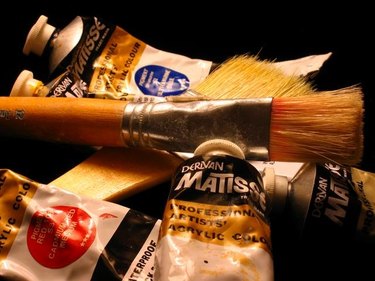
Acrylic paintings are expected to have a longer life span than oil paintings, and are considered more resistant to aging. That is they develop cracks less often than oil paintings and are more resistant to pressure. They are more flexible and are a great choice except when it comes to cleaning. Original art is an investment not only valued monetarily but by being appreciated by future generations and not just those who view it today.
Step 1
Take precautions to ensure an even longer life of your acrylic painting, especially when it comes to cleaning. Many procedures too must be followed also to assure your painting remains in good health.All artwork has a lifespan and even acrylics deteriorate over time. Take measures to prevent unnecessary aging, and reduce the risk of damage and discoloration. As soon as the paint has dried they begin to change. The effects of natural aging, light, heat and humidity, and accidental damage all take their toll but other elements such as dirt can be controlled.
Video of the Day
Step 2
Be aware that acrylic paintings attract and gather dirt more easily than their oil counterparts. Acrylic emulsion tends to be soft at room temperature and that the paint surface will hold onto dust and dirt and even bond them to the surface of the paining. The problem is further intensified by acrylic resins having electrostatic charges on their surface which also will attract dirt. The best resolution when purchasing a new painting is a protective framing to exclude dirt from the painting surface. Accept that as time goes on, acrylic paintings without protective framing will experience some visual change due to dirt deposits and that dirt removal will also cause visual damage.
Step 3
Removal of the top most dirt layer is perceived to be easier on a varnished painting. Varnishes provide surface protection from abrasion, dust and dirt. Varnishing acrylic paintings has problems attached to it. Natural varnishes, such as dammar, will yellow in time and the solvent used in their removal will dissolve or soften the acrylic paint layer, thus damaging your painting. A water soluble varnish may be an answer, however, this is still being researched by manufacturers to see what long term effects may take place.Instead it is important to store acrylic paintings in a dust free environment to reduce the amount of dirt deposited while keeping the display or keep the temperature below standard room temperatures to reduce further softening of the paint film.
Step 4
Smoke may cause the accumulation of soot on your paintings. Try to avoid displaying expensive acrylic paintings in areas where smoking is allowed or near fireplaces.Never attempt to clean the surface of dust by using solvents of cleaning products. Practice proactive prevention. A natural idea that does make sense may be using liquid cleaning. However, liquids may actually embed the dirt into the painting and cause permanent liquid lines over the surface.One home method that is stress free is the use compressed air in a can to blow away surface dust. Another technique involves using a soft sable brush to lightly brush the surface in order to dislodge dust while holding a vacuum, off the surface, to capture and remove debris. Use a delicate brush to gently remove surface dirt from your paintings. Be careful not to bump or scratch the painting. If the paint is damaged in any way, avoid dusting altogether. The back of the painting may be cleaned by vacuuming or brushing, after it is removed from the frame and placed on a clean surface. It is recommended to use a dust cover on the back of the painting to protect it from dirt.
Step 5
Display your painting in the cleanest, lowest traffic area as possible. Vacuum or mop the floors in that area rather than sweeping. This will minimize airborne dusts, which then adheres to your painting’s surface.The most important preventive measure anyone can do to protect their art works is to avoid direct sunlight since it can change the colours of the pigments and cause colors to pale over a period of time. The second measure is to avoid extremes in terms of temperature and humidity, and in particularly sudden and large fluctuations in temperature and humidity. A stable ‘room-temperature’ climate is the most favorable for art works.
Step 6
Seek out professional services as appropriate for the piece and conditions for cleaning. Consider an experienced art conservator who will know the correct method due to their extensive training and experience. The risk of damage to the painting will be much less if it is cleaned by a reputable professional in the field of fine art conservation.
Warning
The extreme cold and sub-zero temperatures can cause acrylic paint to crack. Try and maintain a normal room temperature for your paining. The same applies to the opposite; extreme heat. Avoid high temperatures such as placing painting above a fireplace or heater. Never hang your artwork in direct sunlight. Some pigments found in acrylic paints are extremely sensitive to ultraviolet light. This can cause them to fade.
Video of the Day